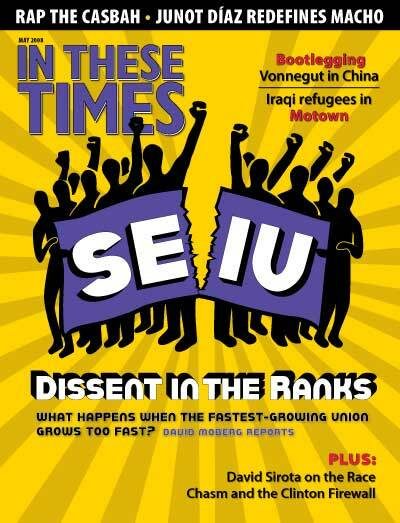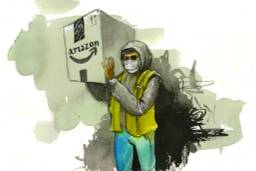
For more than a generation, hip-hop has drawn kids from neighborhoods around the world into the musical intersection of street culture and political consciousness. Now that common ground is making a mark in one of the globe’s most conflict-ridden areas: the Arab world.
Tracing the breadth of the diaspora – from French streetscapes to Gaza slums – Arab youth are seizing hip-hop culture as a platform for self-expression.Dam, a three-member crew based in Lyd, a town outside Jerusalem, documents the bleak realities of segregation, violence and poverty under Israeli rule. (Their name means “blood” in Hebrew and “eternity” in Arabic.)
The group’s breakthrough protest anthem, “Min Irhabi?” (“Who’s a Terrorist?”), released in 2001, reverses a common ideological refrain: “You’re killing us like you’ve killed our ancestors/ You want me to go to the law? What for? You’re the Witness, the Lawyer and the Judge!”
In “Inkilab” (“Revolution”), Dam emcee Suhell Nafar warns “all the people of love and peace”: “How can we have co-existence when we don’t even exist? It takes revolution to find a solution.”
As political marginalization stokes hopelessness among Palestinian youth, Nafar says hip-hop’s mission is “to deliver the positive message, and to let the people know that they’re not terrorists, to let them know that they’re human beings.”
Nafar also notes that music can cross checkpoints and borders more easily than Palestinians can. “We can’t get into Gaza, or go to Nablus, or go to Syria,” he says. “But our music got there a long time ago. There’s no other way to connect.”
On the other side of the barrier, the Gaza-based Palestinian Rapperz (PR) buck at the Israeli occupation with dark, lumbering beats and voices steeped in bitterness. The crew’s trademark symbols invoke graffiti and barbed wire.
“Rap is known for people who struggle, and we are here struggling, so rap is our weapon to defend ourselves,” says emcee Ayman Meghames. With the military paralyzing nearly every facet of life in Gaza, he says, “it’s the only way to express our feelings without getting killed.”
The new documentary Slingshot Hip Hop, by Palestinian-American artist Jackie Salloum, follows the daily travails of Dam, PR and other Palestinian artists. Scenes of studio jams and packed clubs are interspersed with police harassment, a cell-phone conversation with friends in prison and vast landscapes of rubble where neighborhoods once stood.
That atmosphere drove young musicians in the West Bank to channel their frustrations into a hip-hop collective called Ramallah Underground. Named after the region’s cultural hub, the trio’s politically charged rhythms blend trip-hop, electronica and Arab folk sounds.
“We consider our music to be very political, simply because our lives are very political,” says co-founder Stormtrap. “Just the mere fact that we know what’s happening puts a huge weight and responsibility on us to do something about it.”
Hip-hop artists in other parts of the Arab world, while perhaps less explicitly politicized, nonetheless reflect on social tensions that engulf their communities.
Casablanca-based emcee Don Bigg, also known as Al Khaser (or Rude Boy), says class conflict fuels hip-hop in Morocco, which suffers from some of the deepest wealth inequities in the region. Whereas American hip-hop grew out of a racially divided society, he says, in Morocco, “We have the same segregation, but not against Afro-American people, but from the rich [who are] against what we call wlad sha’ab,” or the common people.
In Egypt, where rapid economic change has bred alienation among many youth, the Cairo-based Arab Rap Family tries to intone a message of affirmation through its music. Nadoo, an emcee with roots in both Egypt and the United States, says, “We want them to grow with knowledge about life and history, and the courage to speak their mind and not be negative.”
As they challenge the political and cultural status quo, Arab hip-hop artists are also looking to upset barriers within their own communities. Abeer Alzinaty’s sharp, streetwise voice has complemented Dam and other Palestinian artists on many recordings. But most fans have only heard, not seen, the pioneering Palestinian R&B vocalist, because her family and community have pressured her not to sing publicly. Hamstrung by negative attention, she has limited her performances to venues outside her community in Lyd.
Even within the scene, Alzinaty says some male artists choose to stay quiet on issues of women’s equal right to self-expression – a glaring contrast to their pro-Palestinian activism. “When you get revolution personally in your life,” she says, “people tend to take a step backwards.”
Alzinaty, who plans to relocate to the United States to develop her music, sees hip-hop as a channel for women’s empowerment outside of traditional cultural constraints. “We have a lot of issues to talk about,” she says. “And traditional music can do that, but not as fiercely as hip-hop can, and you can’t really get too angry on a classic song.”
Receiving scant attention from the commercial music industry in their home countries, Arab hip-hop artists remain an underground phenomenon. But through viral Internet marketing, Ramallah Underground, Dam and others have attracted international followings and collaborated with artists in the United States and Europe.
Some Arab hip-hop musicians see their budding community as part of a global revival. Nafar says that while mainstream corporate hip-hop goads people to “shake their asses and to forget about all the stuff that’s really happening,” hip-hop’s original iconoclasm lives on wherever social strife roils.
“This is what we need,” he says. “We’ve been hungry for people who speak freely.”
Michelle Chen is a contributing writer at In These Times and The Nation, a contributing editor at Dissent and a co-producer of the “Belabored” podcast. She studies history at the CUNY Graduate Center. She tweets at @meeshellchen.









